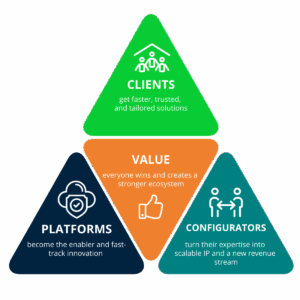The Rise of the Configurator: How Specialists Are Shaping the Future of Enterprise Software.

For decades, enterprise software followed a predictable model: vendors built monolithic applications, and customers adapted their business processes to fit. Updates came when the vendor was ready, features were dictated by the broadest customer base, and specialist needs were often pushed to the sidelines.
That approach worked in an era of slower change. But today’s world is different. Industries are more complex, regulations shift overnight, and business models are reinvented with each market shock. One-size-fits-all software simply can’t keep up.
This is where the Configurator comes in.
Who are Configurators?
Configurators are domain experts. Often boutique consultancies or independent specialists, they can sometimes be the actual customer, they understand complex problems inside out. Partners serving as Configurators don’t try to build generic products for everyone. Instead, they use configurable platforms to turn expertise into tailored solutions that directly meet their clients’ needs.
Think of them as the architects of modern enterprise software. They bring the knowledge, the blueprints, and the flexibility to design something fit-for-purpose, using a platform as their construction material.
Why Configurators are on the rise.
- Speed beats roadmaps Traditional vendors work on long product cycles. A new feature might take a year to design, build, and roll out. For organisations dealing with fast-moving challenges, say, new emissions reporting rules or urgent M&A integration, waiting 12 months just isn’t an option. Configurators can deliver in weeks. Using a configurable platform, they design and deploy solutions directly around the client’s business logic, without waiting for a vendor to put it on their roadmap.
- Credibility comes from lived experience When a business is implementing new software, they increasingly trust specialists who have faced the same problems they’re trying to solve. A consultancy that has run hydrocarbon allocation for decades, or managed emissions verification projects on the ground, speaks with more authority than a software salesperson describing a feature. Configurators draw on this credibility of experience. They’re not theorising about what “might” work. They’re showing what has worked…and configuring it into a repeatable solution.
- Scaling expertise changes the game Traditionally, consultancy has been tied to billable hours. Expertise was sold project by project, limiting impact. But Configurators who build on platforms can package their expertise into scalable solutions. For example, a specialist who designs an emissions reporting framework for one client can adapt the same logic for ten more, each tailored but built from the same proven foundation. This shift transforms consultancies from pure service providers into solution creators, multiplying their reach and their revenue potential.
The value triangle: Clients, Configurators, Platforms.
 This new model works because it creates a win for everyone:
This new model works because it creates a win for everyone:
- Clients get faster, trusted, and tailored solutions that fit their unique needs.
- Configurators turn their expertise into scalable IP and a new revenue stream.
- Platforms become the enabler, fast-tracking innovation without the need for bespoke code or endless customisation.
It’s a triangle of value that makes the whole ecosystem stronger.
Real-world examples.
We’ve already seen this in action:
- In energy: boutique consultancies have used EnergySys to configure advanced emissions tracking and hydrocarbon accounting solutions, deploying them in weeks rather than months. Their credibility with clients came not from being a software vendor, but from having lived the exact allocation and reporting challenges their customers face.
- Beyond energy: in industries like chemical processing or water treatment, specialists are beginning to explore configurable platforms to solve highly specific compliance or optimisation problems that off-the-shelf vendors would never prioritise.
The common thread? Specialists who know their domain deeply can now capture that knowledge in a solution, and deliver it faster, cheaper, and more reliably than ever before.
From vendor-led to Configurator-led.
The rise of the configurator represents a structural change in enterprise software delivery:

This isn’t about replacing vendors altogether – platforms are still essential. But the balance of power is shifting. The real differentiation now comes from the configurators who know how to harness those platforms to solve real-world challenges.
The moment to act.
The message is clear: enterprise software is no longer just about what a vendor builds. It’s about what specialists can configure.
Configurators are turning domain expertise into competitive advantage, not only for their clients, but for themselves. Those who embrace this model will move from being advisors on the sidelines to creators at the centre of enterprise transformation.








